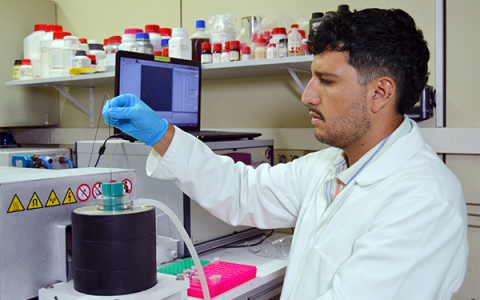ICMM participates in a project to produce green hydrogen more efficiently and economically

Researchers from the Materials Science Institute of Madrid (ICMM) and the Institute of Carbon Science and Technology (INCAR), both part of the Spanish National Research Council (CSIC), will spend three years studying the use of advanced materials to avoid the use of critical minerals and to develop electrodes that produce hydrogen more efficiently and economically. The project has a budget of 2.6 million euros, 1.9 million of which has been financed by the Ministry for Ecological Transition and the Demographic Challenge.
This initiative involves a multidisciplinary team composed of the two CSIC centers, an organization under the Ministry of Science, Innovation, and Universities (MICIU), a group from the Polytechnic University of Madrid, and the companies Water2kW and Graphenea. The main objective is to improve the balance between efficiency and cost in the hydrogen production process, which will be achieved through H2umidity technology, developed by Water2kW. This technology proposes producing green hydrogen even when water sources are unavailable.
“We will incorporate advanced materials to replace the platinum currently used, and we will improve the water electrolysis process by incorporating magnetism,” explains Puerto Morales, a researcher at ICMM-CSIC and part of the project. The plan is to develop an electrolyzer (a device that produces hydrogen) that makes hydrogen production more efficient and cheaper.
Specifically, the ICMM will study how magnetic nanoparticles (with a size that is one billionth of a meter) affect the electrodes and how they impact the water electrolysis process. “We will explore the effect of iron oxide nanoparticles, with different sizes and morphologies, synthesized by sustainable and scalable methods (up to 10 grams),” describes Morales, who adds that these nanoparticles “will be strategically applied” to take advantage of their magnetic properties and their ability to generate heat.
Meanwhile, the INCAR will study the production of synthetic carbon materials doped with graphene, provided by the company Graphenea, for use as electrode material. The Materials for Energy, Environment, and Catalysis group (MATENERCAT) has extensive experience in developing tailored carbon materials for applications in energy and environmental fields. In this project, materials that combine high porosity and high electrical conductivity will be prepared, which will improve the efficiency of the hydrogen production reaction.
“We will develop custom-designed carbon materials that will act as supports for metallic particles (magnetic or not), avoiding the use of critical materials and utilizing a production process that has already been verified on a large scale,” says Natalia Rey, the project leader at INCAR-CSIC.
With all this, the goal is to achieve a 60% improvement in energy efficiency compared to the industry reference value for this type of technology and a 30% reduction in costs at the pre-commercial and commercial levels. This, they assure, will contribute “to the introduction of green hydrogen in industrial activities, as well as the integration of renewable hydrogen supply into the value chain,” concludes Water2kW.
Instituto de Ciencia de Materiales de Madrid (ICMM)
Sor Juana Ines de la Cruz, 3
Cantoblanco, 28049
Madrid, España
Telephone: (+34) 91 334 90 00
Email: @email
Communication Office: @email

Acknowledge the Severo Ochoa Centres of Excellence program through Grant CEX2024-001445-S/ financiado por MICIU/AEI / 10.13039/501100011033

Contacto | Accesibilidad | Aviso legal | Política de Cookies | Protección de datos